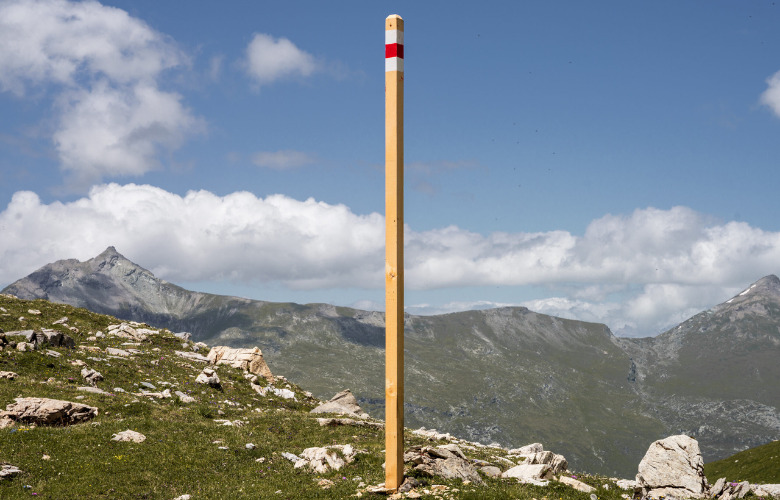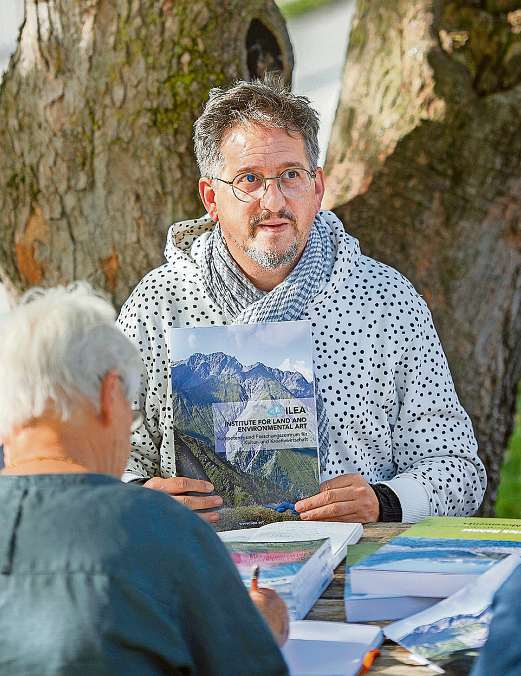
The ART SAFIENTAL Biennial in the Swiss Safiental is taking place right at this moment until October 23rd, 2022. This year the land art is presented under the theme Learning from the Earth. We had the pleasure to be able to interview the founder of Art Safiental, Johannes Hedinger, who gave us a wonderful overview of the unique location of the Biennial. He also shared with us how Art Safiental has developed in the remote Safien valley over the last 8 years, and where the foundation is headed. This is part 2 of 2.
Johannes Hedinger and I met in beautiful Zurich, Switzerland, to speak about his involvement in and his development of Art Safiental and ILEA, the Institute for Land and Environmental Art.
In the first part we looked at the unique location, the Safien valley, as well as into how it had all come about.
A very important part of our work with ILEA is the collaboration with and the participation of the local valley population. They are often included in the production of individual works of art, as well as included in scientific research projects.
Because the local knowledge is enormous, and this makes both artworks and research endeavors more exciting.
In turn, the local population is by now also much more interested in what we are doing. Whereas in the beginning it was more like, “What are these crazy artists and scientists doing here?” now the locals see that we bring new value into their lives as well.
When we have summer academy groups with artists from different nations present, from India, to Columbia, to Africa, then it brings another level of diversity to the traditional mountain villages. This can be challenging, but also very interesting and rewarding.
Over the years, besides building up our 3 pillars: art, education, and research, we have also steadily increased our local network in the Safien valley. Be that working with local carpenters and others, as well as administrative specialists. This is important for both our artistic productions and scientific projects.
When we do scientific projects, it is always connected in some way to art. For example, we have a project in which we do acoustic soundscape research in the forest. This is a long-term project.
Through weather data, ground data, and data from the trees and the forest, we generate music. It becomes an artistic journey as well as a scientific one.
And it involves both us and major Swiss universities, like ETH Zurich.
The artists, musicians, and sound researchers turn data into sounds. It is quite amazing and it turns out it is scientifically possible to make climate change audible.
Then we have other projects of sociological scientific value, in which we do surveys with the Safien valley population.
We have a very transdisciplinary approach. It is not just about exhibiting something. But rather process-oriented, participatory… and the artworks and projects grow. They change over time.
At the moment we have two artists from India with us in the valley. They are in residency for the next 2 months.
And they are building a gras museum in an old barn with their unique outside view. In a sense they are studying the surviving, local building and storage culture.
Because in the old days, there were only small barns. Nowadays, every farmer has a large one for everything. But back in the day it was impossible for the locals to build something this huge. And they didn’t have the machinery to collect and transport hay from everywhere. Thus, they built little barns next to every field, to make storage easier for them.
Most of the remaining, old barns are empty now or used to store random things.
Now the 2 Indians are working inside one of the small, empty barns and transforming it into a gras museum. Gras is the green gold of this valley. For the animals, the people, farming.
The gras museum will look at this with a new eye. And in the 2 months these two artists are here, their installation will keep changing.
By seeing things through these foreigners’ eyes, we learn something as well. It is a cultural exchange. An exchange of different views of the world.
So mostly, it is about learning. Not only Learning from the Earth but also learning from each other. We are a learning organization.
When our participants come to join us at the academy, we teach them, but we also learn so much from them.
The academy participants only stay for 10 days. Mostly this has to do with them not being able to finance it for longer. Long-term we need to aim for partnerships with universities and scientific communities. This is one of our strategic goals for the coming years.
We want to reach a point at which ILEA, the Institute for Land and Environmental Art, will be a hub for art, culture, and scientific research throughout the Swiss Alps.
There is an old hotel from the end of the 19th century, called Alpenblick. It survived for a long time as a family business but will now need a new business strategy.
We are trying to find interfaces, points of contact with them. Trying to find out if there are possibilities for collaboration. At the moment, we are at a big table together, trying to come up with a broader concept.
Every 2 years you can send an application to sign up for summer school at the Alps Arts Academy. You can find the application form here.
Residencies are strongly faculty-driven. There are workshops, seminars, trips. Overall, a lot of input.
We can now offer residencies which can take up to 3 months. Valuable time in the Safien valley during which someone can really focus on the local people, nature, and context.
This can culminate in an artwork, research, an essay, or any other format.
During the 10-day summer academy, on the other hand, this sort of in-depth work is not possible. There is only space and time for smaller exercises. However, I am in awe each time as to how much can be achieved in such a short time.
Immense creative power is unleashed. You can call it almost magical.
There is a website for the Academy, the Art Safiental Biennial, and the ILEA Institute.
The easiest way to participate is to travel to the Safien valley to have a look at our Land Art exhibition.
By now, we also have publications. We have a guide for the Biennial, in which all places are marked where you can find an installation. Plus, there is further information about the artists and their respective artworks.
We also offer guided tours.
During each Biennial we offer an international symposium. This year, this will take place on the 27/28th of August 2022.
You can take part in person, or virtually. For the entire 2 days we will offer a live stream on our website.
Everything that we have produced through research and artistic reflection over the past few years is available as a landscape book. Each book sums up 2 years. The 2nd one will be published next year. It includes essays, photo documentation of the Art Safiental projects and the artworks of the Alps Arts Academy participants, artist talks, etc.

Additionally, audio files are available on our website. For example, 50 interviews we did for our survey of the local population are filed there and accessible for everyone.
We want to share all accumulated knowledge. The material should be available for all to access and work with.
In the future, we will need a better databank for this. But this will require better funding. Thus, for the moment, our detailed web pages are the best we can do.
We are growing and better situated with every passing year. Now, we are at a point at which we have proven our potential. Which should enable us in the coming years to build a stable organization on this solid base.
Currently our core team consists of 5-6 people. Then, depending on each project others will sit at the table with us.
Added to the outside artistic, educational, and scientific team are the locals as well. This is very important to me.
For example, the implementation of an installation is done by the local carpenter. Or the parc or tourism employee plays a role in the overall organization of a project. In this way we have a strong net of connections in the Safien valley as well as with outside specialists.
When it comes to the artists we select for our program, we make sure we have regional, national, and international participants. Diversity and equality are very important.
Age-wise we have individuals from around 30 to over 80. In the summer academy this is a bit less broad, but still ranges from under 30 to over 60 years of age.
It’s not about having to satisfy everyone. But at the same time, we do not want this to become some sort of exclusive ghetto. We want to create as much variety and diversity as possible.
Opening hours Art Safiental:
The artworks are accessible around the clock until October 23rd, 2022.
Events/Performances:
3. Sept 2022: SOUND KITE ENSEMBLE: Performance “Tripe Instruments”
27. / 28. Aug 2022: ILEA TALKS: Symposium
28. Aug 2022: 507 NANOMETER: Performance “Beneath Blind”
3. Sept 2022: Final Presentations
Sa/So 22. / 23. Okt 2022: FINISSAGE
Guided Tours:
INSTITUTE FOR LAND AND ENVIRONMENTAL ART So 18. September / So 9. October 2022
ILEA and Art Safiental on Facebook
‘Tiger on Eiger’ by Swiss Artist to Celebrate Chinese New Year
The Art Biennale ART SAFIENTAL in the Swiss Alps


Liam Klenk was born in Central Europe and has since lived on four continents. Liam has always been engaged in creative pursuits, ranging from photography and graphic design, to writing short stories and poetry, to working in theatre and shows. In 2016, Liam published his first book and memoir, 'Paralian'.
Read Full Profile© 2021 TheatreArtLife. All rights reserved.

Thank you so much for reading, but you have now reached your free article limit for this month.
Our contributors are currently writing more articles for you to enjoy.
To keep reading, all you have to do is become a subscriber and then you can read unlimited articles anytime.
Your investment will help us continue to ignite connections across the globe in live entertainment and build this community for industry professionals.